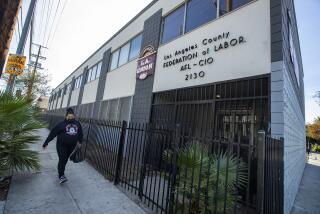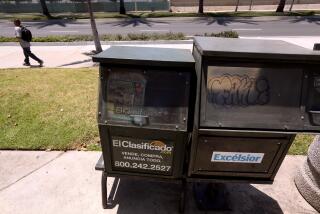TV Brings City Councils to O.C. Homes--Warts and All
- Share via
Sometimes, it’s more like watching “America’s Funniest Home Videos” than the dignified proceedings of representative democracy.
In Tustin, a speaker brandishing a stuffed rooster urged the City Council to lift a longstanding ban on live farm animals. In Newport Beach, a city official--who had tuned in at home--phoned in during a meeting to talk a colleague through technical difficulties he was experiencing with a council video presentation. In Laguna Niguel, a tape-delayed broadcast of a council meeting was yanked from the airwaves after technicians realized that the entire session was recorded without sound.
And nearly every one of the 22 cities in the county that broadcast council meetings can roll tape of residents whose desire to vent their outrage obviously outweighed concerns about personal appearance.
“We had people coming into the council in whatever they were wearing when they were watching--jogging suits, whatever,” recalled former Irvine Mayor Sally Anne Sheridan. “They just were so angry over what they saw, they came down disheveled.”
But in addition to supplying amusing footage for future documentaries, the camera’s gradual introduction into council chambers over the past 10 years has also had a discernible influence on the workings of local democracies, political observers say. Not only have cable broadcasts heightened public knowledge about council machinations as never before, but they also may be affecting the decision-making process itself, some observers contend.
Clearly, the most dramatic effect of public access coverage has been to better inform the public about local government. People who would never sit through the tedium of an entire city council meeting can now sit on their sofas while viewing items which most affect them. Repeat broadcasts and videocassette recorders allow even more residents to watch the meetings at their leisure.
“There are a lot of people out there who won’t come to City Council meetings, but watch it religiously on cable,” said Costa Mesa resident John Feeney, who has more than three years of videotaped council meetings filed away to settle any potential disputes about who said what and when.
Although ratings of council coverage aren’t kept, many elected officials can attest to the broadcasts’ popularity. They say they have been stopped in supermarkets, in restaurants, at parks, and even while walking down the street by strangers who have seen them on the small screen. For council members, the medium carries a message--they are being watched.
“Sometimes you’re on the council and you look out in the audience and there’s nobody there,” said Newport Beach Mayor Clarence J. Turner. “You think you are talking into a vacuum, and you aren’t. People are watching.”
Sheridan humorously learned about the far reach of Irvine’s public access Channel 3 a few years ago when she returned from Los Angeles late one night with her mother. The former mayor nervously noticed a tough-looking biker shadowing her car on the San Diego Freeway.
“The man started waving frantically,” Sheridan said. “I rolled down my window with my mother in tears, and he said, ‘Are you Sally Anne Sheridan?’ And I said, ‘Yes, I am.’ And he said, ‘I voted for you. You look just like you do on TV.’ ”
Council members, some of whom could qualify for guest spots on the loudly fractious “The McLaughlin Group,” concede that the television camera has had a civilizing effect on their public personas.
“I would say there has been noticeable improvement in behavior” since cable, said Mission Viejo Councilman Robert D. Breton. “We used to have antics like walking off the dais and refusing to come back, refusing to vote in order to see how others would vote, name-calling, calling each other out of order and other belligerent behavior. . . . That kind of thing (they) would never have been engaged in if those meetings had been televised.”
Home viewers haven’t been shy about demonstrating their displeasure over council missteps either. Time and again residents--in shorts, thongs and all manner of dress--have gotten up from their couches and marched down to the council chambers to inject their opinions into an ongoing debate.
Sometimes, the cable watchdogs actually change council decisions. In Huntington Beach in 1990, a developer who was outraged over a vote he saw on television raced down to the Civic Center and, after a brief recess, persuaded the council to reverse its original vote on a controversial residential project.
But if elected officials feel pressure to behave better for viewers--aka voters--council members also are aware of the tube’s upside--exposure. Most city officials report there has been grandstanding by many council members, especially when cable coverage first began in their communities.
When the camera clicked on, council meetings mysteriously started to lengthen as council members demonstrated a new fondness for extended speeches, city officials said. Some council members seemed overly attentive to their small-screen image, observers noted.
“Whether it’s conscious or unconscious, they look into the monitor to see how they or their colleagues are coming across,” said Mark Petracca, a professor of political science at UC Irvine.
Of course, council members aren’t the only ones using the camera to their advantage. Gadflies and community activists also try to capitalize on the medium’s large audience. In Newport Beach recently, as placards were waved in front of cameras, National Organization for Women supporters handed out yellow plastic pigs to male council members at one council meeting. The city was investigating sexual harassment allegations against police officers at the time.
“It certainly creates the opportunity for a lot of theater,” added Petracca, who studies cable television and local government.
Council members contend that after a few months of adjusting to the glare of television coverage, they ignore the cameras and concentrate on their jobs.
“Everybody sooner or later may play to the cameras,” said Cypress Councilwoman Gail H. Kerry. “But I think we’ve grown beyond that. After a while you forget the TV is there.”
While he backs cable coverage of local government, Petracca argues its use contains two possible downsides. First, with more people watching meetings at home, fewer people are showing up at council meetings.
“Watching isn’t participating,” Petracca said. “And if you think it is, that could be dangerous since it could create a false sense of involvement.”
Also, Petracca contends, councils may be making important decisions behind the scenes in an effort to avoid appearing overly disagreeable on television. While not technically illegal as long as they aren’t meeting as a group outside of council chambers, the practice deprives the public of the give and take of a healthy debate, Petracca says.
“There are those of us who enjoy the entertainment of a good tiff,” Petracca said. “But most people don’t like conflict and don’t like to see it among their elected officials.
“I’m always rather amazed at the lack of substantive justification for why they voted the way they did, from watching television,” he added.
As widespread as cable coverage is, nine cities in the county still have not adopted the format. Most cities say they want it, but lack the funds to install the technology. In Fullerton, one of the largest communities without council broadcasts, community activist Alan Morton is leading a drive to plug his city into cable TV.
“I find the council has a split personality,” Morton said. “When there’s a full house, they are courteous, cheerful, kind; they’re like Boy Scouts. But when no one is at a council meeting, it’s entirely different. It’s the mice will play when the cat’s away.
“I want to level the playing field, and cable television will do that,” he added.
Other cities without television coverage of council meetings are Orange, Fountain Valley, La Habra, La Palma, Laguna Hills, Lake Forest, San Juan Capistrano and Stanton.
Eventually, political observers predict, every city in Orange County will televise its city council meetings. And as technology improves in the years to come, residents will be able to interact directly with council members from home, via cable boxes that supply officials immediate feedback about their decisions.
In the nearer future, however, voters might soon see council broadcasts play a role in local elections. Snippets from council tapes may soon be used to paint complimentary or unflattering portraits of office seekers, Dana Point Councilman Mike Eggers, a political consultant, predicted.
“When you sit up there for seven hours, it’s hard not to say the wrong word or have a dazed look on your face every once in a while,” Eggers said. “It’s still a relatively new phenomenon, but I wouldn’t be surprised to see it used that way.”
More to Read
Sign up for Essential California
The most important California stories and recommendations in your inbox every morning.
You may occasionally receive promotional content from the Los Angeles Times.













